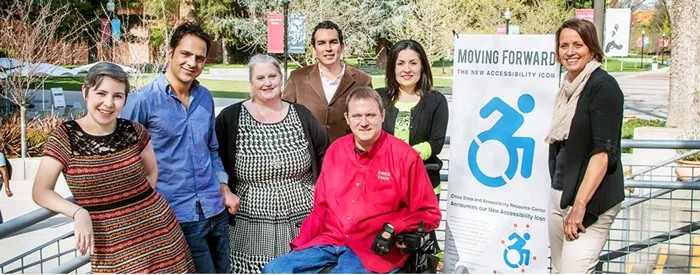It Takes a Village
with Jeremy Olguin, Chico State University
University context: Nurturing Diversity
Chico State is one of 23 campuses in the California State University (CSU) system, and serves a diverse population of over 16,000 students from California and the world. Chico is a point of access into higher education for many first-generation college students and English language learners. Our team at the Office of Accessible Technology and Services (OATS) along with Information Resources (IRES) have been working together to improve student access to inclusive learning environments in support of our Graduation 2025 Initiative.
Goals for Ally: The Accessible Technology Initiative
The Accessible Technology Initiative (ATI) is a system-wide effort to improve accessibility at the CSUs. One of ATI’s key pillars cites the importance of representing learning content in different modalities and formats that suit the needs of diverse learners, as described in the Universal Design for Learning (UDL) guidelines.
We knew based on our institutional report that we would need a programmatic approach that could maximize our resources to support our instructors address the accessibility issues with their course content flagged by Ally. We wanted to make sure to address two areas in our strategy: 1. How do we prepare and support instructors when the Ally indicators appear in their course? 2. How will our team (2 staff, 15 student assistants) handle a potential increase in requests for content remediation?

Implementation Strategy: Dividing up the Labor
We designed a 4-phase campus roll-out of Ally, beginning with a small group of 11 faculty and gradually scaling to a full-campus release after a period of 18 months. We took a very hands-on approach in the early phases of the pilot, using the institutional report to assess the accessibility levels of each course, and then communicating a personalized remediation plan to instructors. The plan included a list of “low hanging fruit” items instructors could fix on their own using Ally, such as adding alternative descriptions to images, and a list of items that our team would fix for them.
The CSUs adopted Ally as part of their effort to address content accessibility issues, and to bolster our commitment to advancing UDL principles in our teaching with Ally’s “alternative formats.”To effectively scale our support, we developed a 2-tier ticketing system that allows us to better manage how we handle remediation requests. When an instructor requests support for an accessibility issue that can be fixed within Ally, a tier-1 ticket is assigned to the instructor’s point of contact, who guides them through the issue. When a file requires more complex work, a tier-2 ticket is assigned to our remediation team. Each tier-2 content item is added to a Box folder, where we can track the time it takes for us to produce an accessible version. This allows us to better approximate our turnaround time when assessing future courses.
Instead of taking a reactive position, we used the institutional report to help inform our pilot strategy: Start small and scale up.”Evaluation and Findings: Students Benefit Directly
Once students were exposed to the alternative formats, we began receiving requests from students and instructors to turn-on the alternative formats in their other courses. One instructor forwarded us a lengthy email from a student requesting access to the alternative formats. The student, a mother who commuted to campus, explained how access to the audio formats allowed her to listen and review course materials on her commute to class. Sharing anecdotes like these with instructors in our communications has helped drive home the value of accessible content to student success. Our remediation team has also found that Ally’s HTML alternative format can be a useful resource for content remediation, as our team will often use the HTML as a more accessible starting point that can be remediated more quickly than the original PDF.
With Ally, we’ve been able to organize a more efficient system for handling content remediation requests that I estimate has reduced remediation time by 25%.As we prepare for the final phase of our Ally roll-out, we want to ensure that our communications reach the necessary voices across campus so that instructors new to Ally are aware about its role within the CSU accessibility initiative and how it can benefit student success. We are also planning to promote the alternative formats provided by Ally through a student campaign during our campus “Welcome Week.”
Pearls of Wisdom: Think Sustainability
When we first opened our institutional report, the accessibility challenges in front of us seemed overwhelming. We tracked each stage of our implementation, including our communication and remediation workflows, to help optimize those processes as we introduced Ally across the campus. Most importantly, we’ve made Ally part of a concerted effort to re-connect key stakeholders and voices at Chico and the CSUs in forming a collaborative effort to help make our campuses more inclusivebecause it truly takes a village!






 Присоединиться к группе пользователей Ally
Присоединиться к группе пользователей Ally